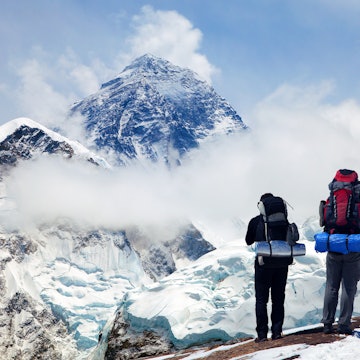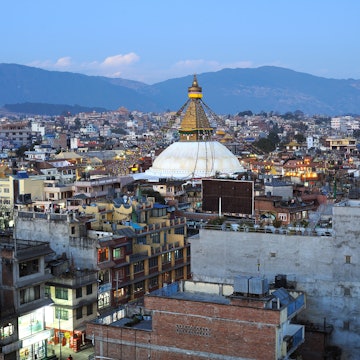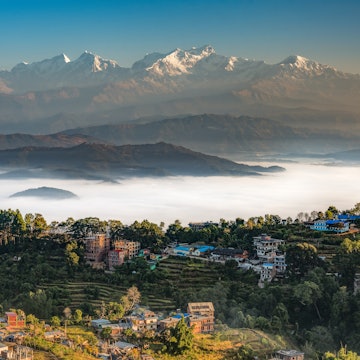
Tragedy and resilience among the Sherpa people of the Himalaya
Jan 10, 2022 • 11 min read

Lhamo Choeki Sherpa's husband went missing after being struck by an avalanche near the summit of Baruntse in 2010 © Monika Deupala / Lonely Planet
Mount Everest is the pinnacle of adventure tourism. For the Sherpa people of Khumbu, it is also both a livelihood and the source of unspeakable hardship.
Sitting on a wooden bench overlooking Namche Bazaar, a remote mountain town in northeastern Nepal, I watched a caravan of mules carrying cooking gas cylinders make its way toward the main road.
It was late afternoon, and the cloudless mid-November sky revealed the towering peaks of Kongde Ri, which flanks the town from the west, and Thameserkhu, from the east, in all their glory.

Namche is the biggest town in the Khumbu region, home to Everest. Ever since the mountain was first summited by Tenzing Norgay, a native of Khumbu, and Sir Edmund Hillary, of New Zealand, in 1953, Everest has single-handedly turned the region into a tourism powerhouse. Khumbu is also home to Nepal’s largest population of Sherpas, an ethnic group with roots in Eastern Tibet.
Since that first Everest ascent, hundreds of ethnic Sherpa from the region have gone on to work as porters, cooks and guides on mountaineering expeditions. The integral role Sherpas have played in Nepal’s mountaineering and trekking industry has made the term ‘sherpa’ synonymous with expedition staff, even though not all ‘sherpas’ are ethnic Sherpa.
I wanted to travel to the region from my home in Kathmandu to shine some light on Sherpa stories, which are so often overshadowed by those of foreign mountaineers and bucket list vacationers.
A town for mountaineers

The most popular way to reach Namche is by boarding a small propeller plane and flying into Lukla’s Tenzing Hillary Airport (elevation 2860m) from Kathmandu. Often called the world’s most dangerous airport, the airport has a runway measuring just 527 meters. Just south of the runway is a steep 600-meter drop into the valley below, and to the north are steep mountains, leaving pilots with no room for error. Since there are no motorable roads in the area, to get around you need to be ready to walk. The 19-km trekking trail from Lukla to Namche meanders up and down precipitous pine- and rhododendron-forested hills and past sleepy Sherpa villages.
For a town where everything from bathroom tiles to rice needs to be flown in from Kathmandu and then carried on the backs of porters and animals, Namche is surprisingly well-appointed. The narrow alleys of the town are lined with cafes that serve cappuccinos and freshly baked pastries. Restaurants feature burgers, biryani, pizzas and poutine. There are banks and clinics. Stores sell both knock-off North Face jackets and genuine ones, which cost twice the monthly salary of an average Nepali.

“Once the goods land at the Lukla airport, we have to manage porters and mules to get the goods up here,” said Pasang Tsering Sherpa, owner of Sherpa Barista, a cafe that serves delicious blueberry apple pie and chocolate mud cake. “It’s not easy running a business here in Namche, but compared to what my father did for a living, I have it much easier.”
Like many of his generation, Pasang’s father once worked as a porter for mountaineering and trekking outfitters. “Back then, people had few options but to work as porters to earn some money,” he said, “But it is that hard-earned money that helped lay the foundation of the bustling Namche that you see today.”

While expedition tourism had once been the town’s lifeblood, the younger generation has found other pursuits within the industry – hospitality, for example – to be a more lucrative path. Plus, it's a lot safer.
Deeper into the mountains
After two days in Namche, I trekked west to the village of Thameteng. The trail began with a short, but steep climb and the tall rhododendron trees quickly gave way to shorter juniper shrubs. I was nearing the end of the treeline.
I was heading to Thameteng in the hopes of meeting Ang Ngimi Sherpa (in Nepal it is common to keep the name of one’s ethnic group as a surname). Mountaineering has historically provided people from the Khumbu region with much-needed employment, but not without a price. In more than a hundred years of Everest expeditions, a total of 312 people have died on Everest: 99 of those – or one-third of the total deaths – were Sherpas. In April 2014, Ang Ngimi’s husband was one of the sixteen Sherpas killed when an avalanche swept across Mount Everest’s notorious Khumbu Icefall. At the time of his death, the father of four had already worked as a climbing guide for six years.

I arrived in the village of Thame (3800m), where I’d be spending the night. Set on a broad flat valley, the village is situated at the base of the Kongde Ri (6187m) and Tengkangpoche (6550m) mountains. From Thame, the village of Thameteng is just a 20-minute hike.
When I reached the top of the hill separating the villages of Thame and Thameteng, a man who introduced himself as Kami Rita Sherpa gave us directions to Ang Ngimi’s house. Kami, 40, told us that he started working as a porter when he was only 16 and that he summited Everest for the thirteenth time in April 2021. When the spring (March to May) and autumn (October to November) climbing seasons end, many like Kami return from the mountains to their villages and help their families in the fields and tend to yaks.
When I reached Ang Ngimi’s house, I found the door locked. My heart sank. Many I had met in her village had told us that she might have already left for another village up in the mountains to graze her yaks.

But then I heard the footsteps of someone running down the steep juniper-covered hill that rose behind the house. It was Ang Ngimi. She was wearing a dark grey chupa, a traditional dress worn by many ethnic groups native to Nepal’s mountainous regions.
She said she didn’t have time to talk – that she had heard her son was sick at school in Namche. “There’s no cellular network in this village so I need to go somewhere else to make a call,” she said. “If he is very sick, I am going to leave for Namche right away.”
"Isn't it too late to head to Namche now?" I asked, noting that it was a 4-hour trek away. But she had already disappeared farther down the hill.
When I finally caught hold of Ang Ngimi, she was standing outside one of the many lodges in the region built to offer meals and basic rooms to trekking groups. She had come to use their telephone, the only one in the village. When she saw me coming, she wiped her tears and smiled. Her son only had a mild fever – she could wait until the morning to make her way to Namche.
Meeting the widows of Everest
Over cups of sweet milk tea in the lodge’s brightly lit dining hall, Ang Ngimi told me how she had single-handedly raised her four children, now aged 20, 18, 16 and 14.

“I never really liked the fact that my husband worked as a climber,” she said. “Every time he left to join mountaineering expeditions, I would be so distressed and worried about his safety that I would have trouble sleeping at night.”
She said that after the death of her husband, she received one million rupees (about US$8370), as insurance compensation. Alpine Ascents, the company that hired her husband, has sponsored her children’s education as well. After the calamitous 2014 spring Everest climbing season, which resulted in the death of 16 climbing guides, the government raised the mandatory minimum insurance cover for sherpas on Everest to Rs 1.5 million from Rs 1 million.

Even with the help, the sudden loss of her family’s income meant that Ang Ngimi had to take whatever small opportunities came her way to make money in these remote, desolate mountains.
“I grow and sell potatoes, go up in the mountains to cut grass, which I sell to families that raise livestock, and take care of my yaks. During the climbing season, I also drive my yak train and transport cargo to Everest Base Camp,” said Ang Ngimi. “It is challenging but when has life never been challenging in these mountains?”

I began the trek from Thame to Thamo late in the morning and arrived late in the afternoon. I settled down for lunch at Mt Everest Camp 2 lodge, an establishment run by 70-year-old Ang Riku Sherpa. Ang Riku's husband was also on Everest in 2014 when the fatal avalanche struck. His body was never found.
The fateful 2014 Everest expedition was supposed to be Ang Riku’s husband’s last expedition, after which he planned to retire and run the lodge with his wife.
Ang Riku now runs the lodge alone, doing everything from cooking to cleaning. Depending on the season, the small garden outside her house provides her with carrots, potatoes, cauliflower, radishes or pumpkins. For our lunch, she picked spinach and carrots from her garden and made a vegetable curry.

“My husband and I were supposed to run this place together, and now I am doing it alone. It does get very lonely at times,” she said as she began to cry. “It’s easier when there are tourists at the lodge. But in the last two years, with very few tourists coming into the region, I have had much more free time. I miss him more these days. But life’s got to go on until it stops, right?”
At Tashi Dele Restaurant and Lodge, across the road from Ang Riku’s lodge, I met Lhamo Choeki Sherpa. Her husband went missing after being struck by an avalanche near the summit of Baruntse (7162m) in 2010. With 19 Everest summits, he was an acclaimed climber, and his death shocked Khumbu’s tight-knit mountaineering community. He left behind two sons, who are now 24 and 22.

Lhamo, a calm and soft-spoken woman, insisted that we first drink something before we got talking. She also requested that I not ask her about the details of her husband’s death. It was clear that the grief was still deep.
She told me that when her husband was alive, they lived in Kathmandu, where her kids went to school. Today she gets by with the lodge and by selling potatoes in the off-season. One of her sons sends money back from the United States, where he moved with a scholarship in 2018.
Before I left, I asked Lhamo what she thinks generally about mountaineering as a profession.

“I understand people have compulsions that lead them to work in the mountains, but the profession puts families through a lot of mental and emotional anguish, and in worst-case scenarios, unbearable grief,” she said.
The Nepali mountaineer reclaiming the Himalaya
From grief to triumph
But then there is Nima Doma Sherpa, a native of the village of Khumjung, one of the largest villages in the Khumbu region. I met Nima in Kathmandu before making my trip to the Khumbu region. Her husband also died on an expedition up Everest in 2014.
“His death broke me completely,” she said. “Several Nepali and foreign journalists interviewed me, and I told them I would never look at the mountains again.”

Two years after his death, Nima moved to Kathmandu to be closer to her children who went to schools in the city. In 2017, unable to find professional opportunities away from the mountains, she started working as a trekking guide.
“While working as a trekking guide, I started thinking about my late husband’s dream to summit Everest,” she said. “He died before he could fulfill that dream, and I thought that the best way to honor his memory was by summiting Everest and so I began preparing for it."
After months of training – both physical and psychological – in May 2019, Nima and another widow of a mountaineer reached the top of the world's highest mountain.
On my final morning in Namche, I woke up early and walked around the town for one last time. Most shops were still closed. Half-asleep workers were busy getting their restaurants ready to welcome tourists coming for breakfast. In one of the narrow alleys, I watched an elderly woman stoop and burn juniper leaves, a daily Sherpa ritual.

On my return trek to Lukla, I met a group of teenage Sherpa boys returning home from school. I asked them what they wanted to be when they grew up. One said he wanted to be a doctor; the other said a teacher. One said he wanted to go to New York; the fourth one giggled and said he wanted to become a pilot. Not a single one of them said they wanted to be a mountaineering guide.
You might also like:
How to trek to Everest Base Camp
Dos and don'ts for your Everest Base Camp trek
How to choose a responsible travel operator
Nepal is on our 2022 Best in Travel list. For more stories from some of the world’s most exciting destinations click here.
Safety recommendations and restrictions during a pandemic can change rapidly. Lonely Planet recommends that travelers always check with local authorities for up-to-date guidance before traveling during Covid-19.















